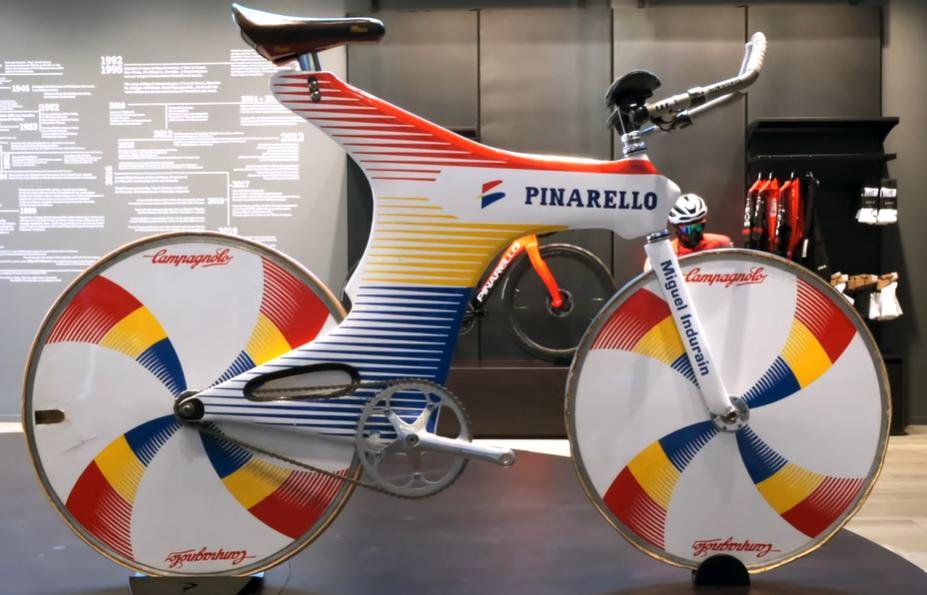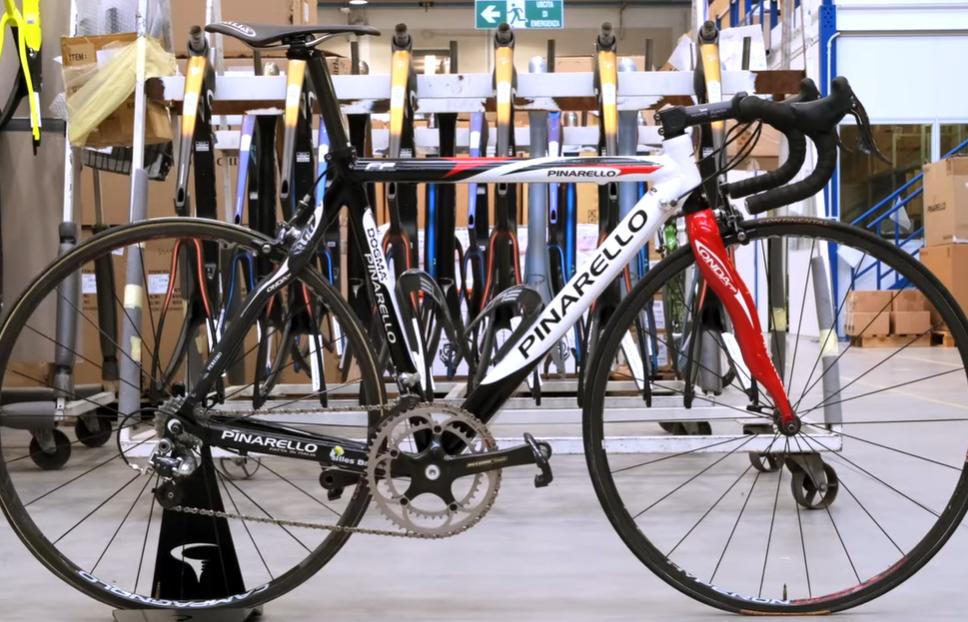- News
- Reviews
- Bikes
- Components
- Bar tape & grips
- Bottom brackets
- Brake & gear cables
- Brake & STI levers
- Brake pads & spares
- Brakes
- Cassettes & freewheels
- Chains
- Chainsets & chainrings
- Derailleurs - front
- Derailleurs - rear
- Forks
- Gear levers & shifters
- Groupsets
- Handlebars & extensions
- Headsets
- Hubs
- Inner tubes
- Pedals
- Quick releases & skewers
- Saddles
- Seatposts
- Stems
- Wheels
- Tyres
- Tubeless valves
- Accessories
- Accessories - misc
- Computer mounts
- Bags
- Bar ends
- Bike bags & cases
- Bottle cages
- Bottles
- Cameras
- Car racks
- Child seats
- Computers
- Glasses
- GPS units
- Helmets
- Lights - front
- Lights - rear
- Lights - sets
- Locks
- Mirrors
- Mudguards
- Racks
- Pumps & CO2 inflators
- Puncture kits
- Reflectives
- Smart watches
- Stands and racks
- Trailers
- Clothing
- Health, fitness and nutrition
- Tools and workshop
- Miscellaneous
- Buyers Guides
- Features
- Forum
- Recommends
- Podcast
The secrets of the most successful Grand Tour bike brand — behind the scenes at Pinarello

This article includes paid promotion on behalf of Pinarello
You might have noticed that here at road.cc, we've always got an eye and an ear out for the latest road bike tech. Will the resurgence of the aero bike continue? Are lightweight bikes making a comeback? Will the new breed of do-it-all road race bikes continue to reign supreme? One esteemed manufacturer who has said all along that do-it-all is the way to go is Pinarello, and they just so happen to be the most successful bike brand in Grand Tour history, with riders in seven of the last 13 Tour de France editions winning on one of these Italian beauties.
This is the new Dogma F, and let’s be honest, it has a lot to live up to! No bike brand comes close when it comes to the sheer of number of Grand Tour victories, and we wanted to find out what the secret sauce is.
The marketing info says a lot about combining handling, comfort and aerodynamics, and having ridden the bike I can certainly vouch for it being very good at all three. But just how do you make one bike the right bike for every situation?
"It's a balance", says Massimo Poloniato, R+D engineer at Pinarello.
"Safety, stiffness, the handling while descending... this is the reason why we are doing one bit to fit all.
"We never start from scratch, we always start from the current product. We need to combine the engineering side, improving the numbers of the bike, and the design to give our story behind it."
Before work began on this new Dogma, it's fair to say the outgoing model was already a highly regarded bike, scoring a 9/10 in our review and picking up a road.cc Recommends award (a review of the new one is coming soon too).
You can tell that aerodynamics has clearly been a big focus of the new Dogma, and everywhere I look I can see aero details. The end to the thru-axle is enclosed, the front end is slimmer and the downtube has been revamped. One could say it's an aero bike then, however the 6.8kg weight - bang on the UCI limit - and the other considerations to ensure the Dogma F will perform in any situation would suggest otherwise.
The pioneers of 'do-it-all'
Pinarello was one of the first to introduce the pro peloton to this breed of aero and lightweight bike, and now we’re seeing lots of other manufacturers follow suit.
Team Sky, arguably the world's first cycling super team, were riding Pinarello for all of their famous Grand Tour victories. It's fair to say Sky - now Team Ineos of course - have never been short of funds, so it's telling that the team continues to choose Pinarello when they could presumably take their pick from any bike brand in the world.
A Pinarello history lesson
To find out more about where bikes are going in the future, it’s useful to look to the past. Luckily for us there was no shortage of race-winning bikes lying around at Pinarello HQ!
There were bikes on display dating right back to the 1960s when Pinarello started sponsoring racing teams, but really I think that Miguel Induráin's striking Pinarello Espada time trial bike (above) is where you start to see the beginnings of the modern road race bike.
The Espada was designed in the wind tunnel and made from carbon fibre, nothing like the round steel tubes that had gone before it. Of course this is now commonplace, but did you know that it was Pinarello and Lamborghini engineer that brought this kind of technology to the world of road cycling?
Carbon fibre was the future then, but Pinarello's early carbon drop bar race bikes were designed with lightweight in mind first and foremost. It soon became clear to Pinarello that they should be combining both aerodynamic performance and low weight, and the answer was the Dogma FP (above). The unique shape of the fork is now a classic feature of Dogma bikes that still influences the silhouette of the current Dogma F.
The Dogma F2 might just be my favourite, a bike synonymous with Team Sky and Mark Cavendish. Cav isn’t just known for being the most successful sprinter of all time, but also extremely particular about the equipment that he uses. When asked at the time how he would improve on the F2, Cav simply said it was "the perfect frame". High praise indeed!
Improve upon it Pinarello did though, taking this winning 'one bike for everything' recipe and evolving it with each generation.
The F8 is perhaps the most famous race bike since the turn of the century, with its 'nose cone' imitated across the pro peloton in the search for marginal gains. The F10 kept the wins coming, the F12 X-Light proved that disc brake bikes could indeed win on the world’s toughest mountains, and then the Dogma F came along.
While the Dogma F is undoubtedly at the forefront of road bike innovation, it's stayed true to its heritage and doesn't follow the same mould as the competition.
Although this latest bike does look quite similar to the generation before it, if you look a little closer you’ll realise quite a lot has been tweaked. The headtube is obviously deeper, but it’s less obvious that the whole downtube is thinner.
Without riding it you might not realise that the carbon layup has completely changed. The Dogma F uses a higher tensile modulus carbon to boost lateral stiffness, the seat clamp has moved, the bottom bracket has been tilted 3 degrees for a 1% improvement in BB aero performance, and there’s a new Talon aero bar.
By themselves these are minor changes, but when you take one of the best road race bikes in the world and improve it by 1% here and 1% there, I guess that’s what makes a Pinarello a Pinarello.
Why is the Pinarello Dogma F the perfect race bike?
We think we have a pretty good idea of what makes Pinarello road bikes special, but what about Pinarello themselves?
"Our goal has always been the same: let's make the best bike that helps the best riders", says Federico Sbrissa, Pinarello's chief marketing officer.
"The Dogma F is the bike to do everything... we try to do what [the athletes] ask, and the new Dogma F is an evolution of our concept.
"It's not drastic, there's no crazy designs or solutions, it's a continuous evolution.
"We see the articles online joking about the little 0.2-0.3% improvements, which I understand sounds not significant! But when you ride the bike, when you're willing to invest, you're definitely going to notice the difference."
Before riding the Dogma, I must admit I didn’t necessarily understand the hype. I thought that having one bike for every situation would lead to compromise, and that the engineers were continuing to go for form over function with the 'Onda' curvy fork.
Having ridden it though, I now get it. It's all about that balance, and the Dogma F is what a race bike should be, in that it's able to cope with whatever situation you throw at it. Pinarello doesn't care that it's markedly different to other race bikes on the market; they care first and foremost that it's deserving of the Pinarello name, a name that has been written in the pro cycling history books many times. Who knows what new chapters this latest incarnation will write?
Let us know which generation of Pinarello is your favourite, and head over to Pinarello's website for more info on the Dogma F.
Jamie has been riding bikes since a tender age but really caught the bug for racing and reviewing whilst studying towards a master's in Mechanical engineering at Swansea University. Having graduated, he decided he really quite liked working with bikes and is now a full-time addition to the road.cc team. When not writing about tech news or working on the Youtube channel, you can still find him racing local crits trying to cling on to his cat 2 licence...and missing every break going...











No. Because they're still driving.
That's more than double my car mileage but I'm kinda in the same boat, but I don't feel jealous of folk I'd rather have the freedom to spend my...
The intent is interesting - you might argue that the intent is deterrent and you never intend anyone to actually come into contact with the gas - a...
Looking at no-one in particular
I like the measure of effectiveness of the new Hutch tires, % of wattage improvement. Instead of saying, "28.6 watts at 49.34 km per mile a nano...
Random driver account: "cyclists should be made to wear hi viz like workers do on a building site"....
"The algorithm" served me an older JV video last week which I now can't get out of my head....
Is that normal for that spot? Pretty sure sand (and/or other sand-like substances) is commonly used to soak up spilled diesel, so if a load of sand...
Holy thread resurrection Batman!